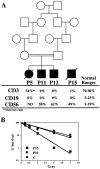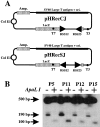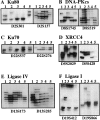A human severe combined immunodeficiency (SCID) condition with increased sensitivity to ionizing radiations and impaired V(D)J rearrangements defines a new DNA recombination/repair deficiency
- PMID: 9705945
- PMCID: PMC2213354
- DOI: 10.1084/jem.188.4.627
A human severe combined immunodeficiency (SCID) condition with increased sensitivity to ionizing radiations and impaired V(D)J rearrangements defines a new DNA recombination/repair deficiency
Abstract
The products of recombination activating gene (RAG)1 and RAG2 initiate the lymphoid-specific phase of the V(D)J recombination by creating a DNA double-strand break (dsb), leaving hairpin-sealed coding ends. The next step uses the general DNA repair machinery of the cells to resolve this dsb. Several genes involved in both V(D)J recombination and DNA repair have been identified through the analysis of in vitro mutants (Chinese hamster ovary cells) and in vivo situations of murine and equine severe combined immunodeficiency (scid). These studies lead to the description of the Ku-DNA-dependent protein kinase complex and the XRCC4 factor. A human SCID condition is characterized by an absence of B and T lymphocytes. One subset of these patients also demonstrates an increased sensitivity to the ionizing radiation of their fibroblasts and bone marrow precursor cells. This phenotype is accompanied by a profound defect in V(D)J recombination with a lack of coding joint formation, whereas signal joints are normal. Functional and genetic analyses distinguish these patients from the other recombination/repair mutants, and thus define a new group of mutants whose affected gene(s) is involved in sensitivity to ionizing radiation and V(D)J recombination.
Figures




References
-
- Alt FW, Oltz EM, Young F, Gorman J, Taccioli G, Chen J. VDJ recombination. Immunol Today. 1992;13:306–314. - PubMed
-
- McBlane JF, van Gent DC, Ramsden DA, Romeo C, Cuomo CA, Gellert M, Oettinger MA. Cleavage at a V(D)J recombination signal requires only RAG1 and RAG2 proteins and occurs in two steps. Cell. 1995;83:387–395. - PubMed
-
- Mombaerts P, Iacomini J, Johnson RS, Herrup K, Tonegawa S, Papaionnou VE. RAG-1 deficient mice have no mature B and T lymphocytes. Cell. 1992;68:869–877. - PubMed
-
- Shinkai Y, Rathbun G, Lam KP, Oltz EM, Stewart V, Mendelsohn M, Charron J, Datta M, Young F, Stall AM, Alt FW. RAG-2 deficient mice lack mature lymphocytes owing to inability to initiate V(D)J rearrangement. Cell. 1992;68:855–867. - PubMed
-
- Schwarz K, Gauss GH, Ludwig L, Pannicke U, Li Z, Linder D, Friedrich W, Seger RA, Hansen-Hagge TE, Desiderio S, et al. RAG mutations in human B cell–negative SCID. Science. 1996;274:97–99. - PubMed
Publication types
MeSH terms
Substances
LinkOut - more resources
Full Text Sources
Other Literature Sources
Medical
Research Materials
Miscellaneous

